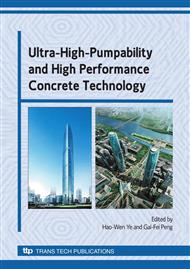[3]
T.H. Phan, M. Chaouche, and M. Moranville. Influence of organic admixtures on the rheological behaviour of cement pastes. Cement and Concrete Research, Vol. 36, 2006, pp.1807-1813.
DOI: 10.1016/j.cemconres.2006.05.028
Google Scholar
[4]
J. Bjornstrom and S. Chandra. Effect of superplasticizers on the rheological properties of cements. Materials and Structures, Vol. 36, December, 2003, pp.685-692.
DOI: 10.1007/bf02479503
Google Scholar
[5]
F. Puertas, H. Santos, M. Palacios, and S. Martı´nez-Ramı´rez. Polycarboxylate superplasticiser admixtures: effect on hydration, microstructure and rheological behaviour in cement pastes. Advances in Cement Research, Vol. 17, No. 2, April, 2005, pp.77-89.
DOI: 10.1680/adcr.2005.17.2.77
Google Scholar
[6]
J.H. Mork and O.E. Gjorv. Effect of Gypsum-Hemihydrate Ratio in Cement on Rheological Properties of Fresh Concrete. ACI Materials Journal, Vol. 94, No. 2, March-April, 1997, pp.142-147.
DOI: 10.14359/295
Google Scholar
[8]
L.D. Schwartzentruber, R. L. Roy, and J. Cordin. Rheological behaviour of fresh cement pastes formulated from a Self Compacting Concrete (SCC). Cement and Concrete Research, Vol., No. 36, 2006, pp.1203-1213.
DOI: 10.1016/j.cemconres.2004.10.036
Google Scholar
[9]
Y.X. Shi, I. Matsui, and N.Q. Feng. Effect of compound mineral powders on workability and rheological property of HPC. Cement and Concrete Research, Vol. 32, 2002, pp.71-78.
DOI: 10.1016/s0008-8846(01)00631-7
Google Scholar
[10]
M.N. Abou-Zeid and M.M. Fakhry. Short-Term Impact of High-Aggregate Fines Content on Concrete Incorporating Water-Reducing Admixtures. ACI Materials Journal, Vol. 100, No. 4, July-August, 2003, pp.280-285.
DOI: 10.14359/12665
Google Scholar
[11]
S.D. Hwang, K.H. Khayat, and O. Bonneau. Performance-Based Specifications of Self-Consolidating Concrete Used in Structural Applications. ACI Materials Journal, Vol. 103, No. 2, March-April, 2006, pp.121-129.
DOI: 10.14359/15263
Google Scholar
[12]
L. Rudzinski. The effect of fly ashes on the rheological behaviour of cement pastes. Materials and Structures, Vol. 17, No. 101, 1984, pp.369-373.
DOI: 10.1007/bf02478709
Google Scholar
[13]
Y.X. Shi, I. Matsui, and Y.J. Guo. A study on the effect of fine mineral powders with distinct vitreous contents on the fluidity and rheological properties of concrete. Cement and Concrete Research, Vol. 34, 2004, pp.1381-1387.
DOI: 10.1016/j.cemconres.2003.12.031
Google Scholar
[14]
M. Bederina, M.M. Khenfer, R.M. Dheilly, and M. Que´neudec. Reuse of local sand: effect of limestone filler proportion on the rheological and mechanical properties of different sand concretes. Cement and Concrete Research, Vol. 35, 2005, pp.1172-1179.
DOI: 10.1016/j.cemconres.2004.07.006
Google Scholar
[15]
H.W. Reinhardt and T. Wustholz. About the influence of the content and composition of the aggregates on the rheological behaviour of self-compacting concrete. Materials and Structures, Vol. 39, 2006, pp.683-693.
DOI: 10.1617/s11527-006-9102-3
Google Scholar
[16]
A. Yahia, M. Tanimura, and Y. Shimoyama. Rheological properties of highly flowable mortar containing limestone filler-effect of powder content and W/C ratio. Cement and Concrete Research, Vol. 35, 2005, pp.532-539.
DOI: 10.1016/j.cemconres.2004.05.008
Google Scholar
[17]
S. Rajgelj. Cohesion aspects in rheological behaviour of fresh cement mortars. Materials and Structures, Vol. 18, No. 104, 1985, pp.109-114.
DOI: 10.1007/bf02473377
Google Scholar
[18]
J. Kaufmann, F. Winnefeld, and D. Hesselbarth. Effect of the addition of ultrafine cement and short fiber reinforcement on shrinkage, rheological and mechanical properties of Portland cement pastes. Cement and Concrete Composites, Vol. 26, 2004, pp.541-549.
DOI: 10.1016/s0958-9465(03)00070-2
Google Scholar
[19]
M. Westerholm, B. Lagerblad, and E. Forssberg. Rheological properties of micromortars containing fines from manufactured aggregates. Materials and Structures, 2006, in press.
DOI: 10.1617/s11527-006-9173-1
Google Scholar
[20]
T.L.H. Nguyen, N. Roussel, and P. Coussot. Correlation between L-box test and rheological parameters of a homogeneous yield stress fluid. Cement and Concrete Research, Vol. 36, 2006, pp.1789-1796.
DOI: 10.1016/j.cemconres.2006.05.001
Google Scholar
[21]
O.H. Vallevik, A. Saasen, and O.E. Gjorv. Effect of filler materials on the rheological properties of fresh concrete. ACI Materials Journal, Vol. 92, No. 5, Sept. -Oct., 1995, pp.524-528.
Google Scholar
[22]
M.A. Rahman and M. Nehdi. Effect of Geometry, Gap, and Surface Friction of Test Accessory on Measured Rheological Properties of Cement Paste. ACI Materials Journal, Vol. 100, No. 4, July-August, 2003, pp.331-339.
DOI: 10.14359/12672
Google Scholar
[23]
S. Grunewald and J.C. Walraven. Parameter-study on the influence of steel fibers and coarse aggregate content on the fresh properties of self-compacting concrete. Cement and Concrete Research, Vol. 31, 2001, pp.1793-1798.
DOI: 10.1016/s0008-8846(01)00555-5
Google Scholar
[24]
V. Corinaldesi and G. Moriconi. Durable fiber reinforced self-compacting concrete. Cement and Concrete Research, Vol. 34, 2004, pp.249-254.
DOI: 10.1016/j.cemconres.2003.07.005
Google Scholar
[25]
K.H. Khayat and Y. Roussel. Testing and performance of fiber-reinforced, selfconsolidating concrete. Materials and Structures/Mat6riaux&Constructions, Vol. 33, July, 2000, pp.391-397.
DOI: 10.1007/bf02479648
Google Scholar


